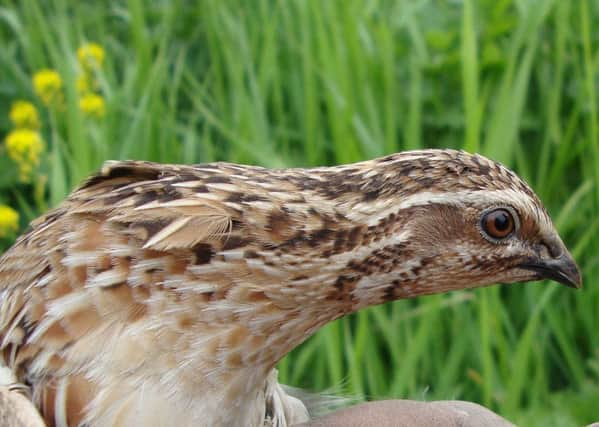Birdwatch: '˜Wet-me-lips' call from returning quails


This plump little bird has been singing, usually unseen, in grasslands and barley fields across Yorkshire this week.
The song is not very loud but very distinctive, a thin ‘sip sip sip’ sound, also described as ‘wet-me-lips’, repeated several times from the depths of the field and best listened for at night or early morning.
Advertisement
Hide AdAdvertisement
Hide AdThe singer rarely emerges although he might pop up his head, striped black and yellow, above the tall grass or make a brief flight.
The quail is Europe’s only fully migratory gamebird and recent studies have revealed some interesting quirks in its behaviour.
Some arrive in North Africa from further south in December and nest there in February before crossing the Mediterranean the following month to move north with some heard calling in this country from mid-April,
There is then a second migration wave in April and May pushing more quail into northern Europe and it is some of these that we are starting to hear now.
Advertisement
Hide AdAdvertisement
Hide AdSome are likely to be birds born this year in North Africa - young quail can fly at 19 days, are ready to migrate further north just two months after hatching, and are able to breed themselves later in the summer.
This system of relay reproduction is seen in Painted Lady and several other butterfly species, but not in other European birds.
Numbers arriving here fluctuate greatly from summer to summer depending on how successful the first breeding season in North Africa has been and we can expect more quail to arrive here next month and in August.
A common crane moved up the Yorkshire coast at the weekend, first being reported over Spurn and surrounding areas before moving on to Flamborough Head where it was seen in various places around the headland before flying low over the RSPB’s Bempton Cliffs reserve. It has continued to be seen there this week.
Advertisement
Hide AdAdvertisement
Hide AdA turtle dove has also been showing well on the reserve while others have been reported near the visitor centre at Sutton Bank, North Yorkshire.
A female red-necked phalarope was present on Beacon Ponds and Kilnsea wetland this week after first being reported on Sunday.
A spoonbill was seen again at Kilnsea, another at Nosterfield, North Yorkshire and up to four are still being reported on the Fairburn Ings reserve near Castleford.
The female Montagu’s harrier has reappeared at the Blacktoft Sands reserve while there is plenty of activity from marsh harriers and barn owls as they feed their broods. The first waders on their way back south from Arctic breeding sites are also starting to be seen.
Birders have been heading Teesside to see an adult rose-coloured starling first reported in a garden in Billingham on Sunday and nearby a singing marsh warbler at the Bowesfield Marsh reserve.